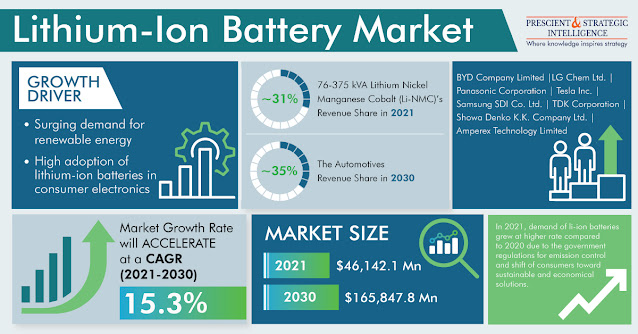The U.S. lithium-ion battery market is experiencing robust growth, propelled by the increasing demand for electric vehicles (EVs), the rising importance of renewable energy storage, growing sustainability concerns, and the burgeoning sale of consumer electronics such as smartphones and laptops. Valued at approximately USD 15.3 billion in 2024, the market is projected to reach USD 65.1 billion by 2032, registering a compound annual growth rate (CAGR) of 20.3% during the forecast period.
Key Growth Drivers
-
Electric Vehicle Adoption:
The transition from internal combustion engine vehicles to EVs is a significant driver of lithium-ion battery demand. Government incentives and subsidies are encouraging the manufacturing and purchase of EVs, contributing to market growth. -
Renewable Energy Integration:
As the U.S. shifts towards renewable energy sources, the need for efficient energy storage solutions like lithium-ion batteries becomes critical to manage supply and demand effectively. -
Consumer Electronics Demand:
The proliferation of smartphones, laptops, and other portable devices continues to fuel the demand for reliable and long-lasting lithium-ion batteries.
Technological Advancements
Innovations in battery technology are addressing traditional challenges such as safety and charging times. For instance, companies are developing batteries with liquefied gas electrolytes, which reduce fire risks and allow for faster charging, while also lowering production costs by minimizing the use of expensive metals like cobalt and nickel.
Market Segmentation
-
By Application:
The automotive sector holds the largest share of the market, driven by the surge in EV adoption. Other significant applications include consumer electronics, aerospace and defense, healthcare, telecom, and industrial uses. -
By Capacity:
Batteries with capacities ranging from 0–3000 mAh to more than 60,000 mAh cater to diverse applications, from small electronic devices to large-scale energy storage systems.
Regional Insights
The western region of the U.S. currently dominates the market, attributed to the presence of major technology companies and favorable policies supporting clean energy initiatives. The southern region is the fastest-growing, driven by increasing investments in renewable energy projects and supportive regulatory frameworks.
Future Outlook
The U.S. lithium-ion battery market is poised for significant expansion, underpinned by technological advancements, supportive government policies, and the growing emphasis on sustainable energy solutions. As the nation continues to prioritize clean energy and reduce carbon emissions, lithium-ion batteries will play a pivotal role in powering the future.












